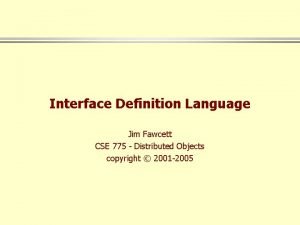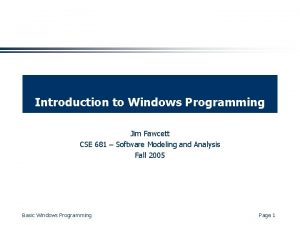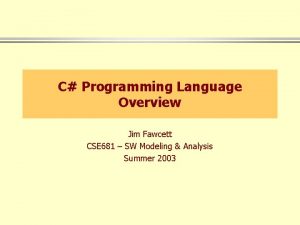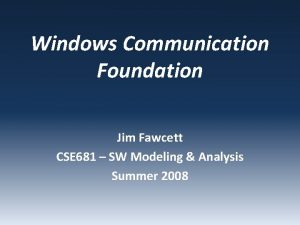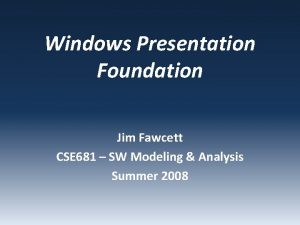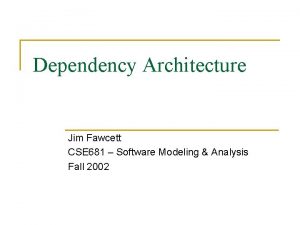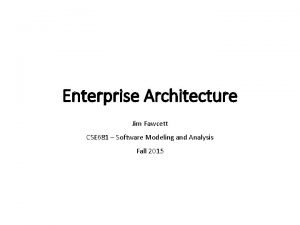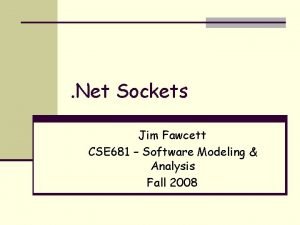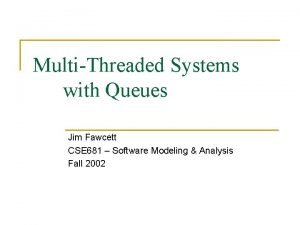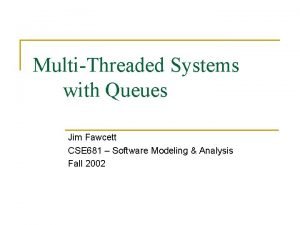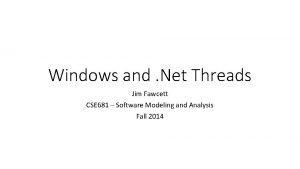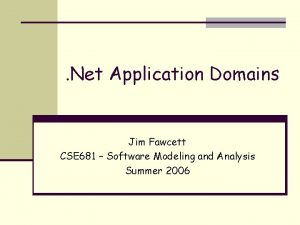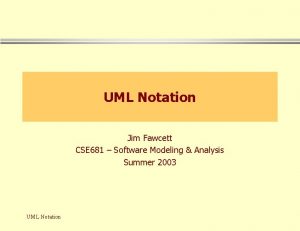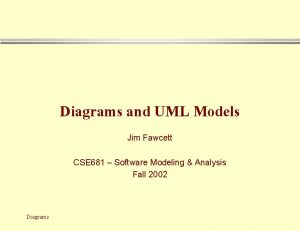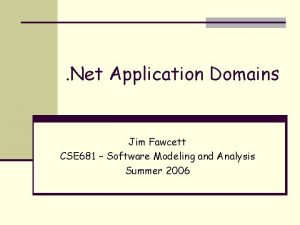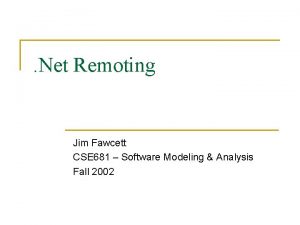Programming with C Jim Fawcett CSE 681 SW

















- Slides: 17

Programming with C# Jim Fawcett CSE 681 – SW Modeling & Analysis Fall 2014

Overview n Terminology n Managed Code n Taking out the Garbage n Interfaces

Terminology n CLI: Common Language Infrastructure n CTS: Common Type System, the. Net types n Metadata: type information in assembly n VES: Virtual Execution System - provided by CLR n IL: Intermediate Language n CLS: Common Language Specification. § Core language constructs supported by all. Net languages. n CLR is Microsoft’s implementation of CLI.

Managed Code n CLR provides services to managed code: n Garbage collection n Exception handling n Type discovery through metadata n Application domains and contexts § Fault isolation § Interception • Security management • Attributes

. Net Assembly Structures

Taking out the Garbage n All. Net languages, including C# use garbage collection n Garbage collection is a multi-tiered, non-deterministic background process n You can’t deallocate resources immediately when objects go out of scope.

More about Garbage n C# provides destructors which implement Finalize() for disposing of unmanaged resources. n n Destructors allow you to tell the garbage collector how to release unmanaged resources. You should Implement IDisposable: : Dispose() n Users of your class call it’s Dispose() to support early release of unmanaged resources n Your dispose should call Dispose() on any disposable managed objects aggregated by your class and unregister event handlers. n Your member functions should call Dispose() on any local disposable managed objects.

Implementing Dispose() n Here’s the standard way: public void Dispose() { Dispose(true); // garbage collector calls Dispose(false) GC. Suppress. Finalize(this); } private void Dispose(bool disposing) { if(!this. disposed) { if(disposing) { // call Dispose() on managed resources. } // clean up unmanaged resources here. } disposed = true; // only call once }

Minimizing Garbage n If you have local managed objects in frequently called methods, consider making them members of your class instead. n Using member variable initializers is convenient: class X { private: array. List col = new Array. List(); … } but don’t if col may be reinitialized to something else in a constructor. That immediately generates garbage.

Try - Finally n Managed classes that use unmanaged resources: handles, database locks, … Implement Dispose() and Finalize() to provide for early, and ensure eventual, release of these resources. n But Dispose() may not be called if the using code throws an exception. To avoid that, catch the exception and use a finally clause: try { /* code using disposable x */ } catch { /* do stuff to process exception */} finally { x. Dispose(); }

The using short-cut n C# provides a short cut for try-finally: using(x) { /* use x object */ } is equivalent to: try { /* use x object */} finally { x. Dispose(); } n You can’t have multiple objects in the using declaration. You will need to nest the using statements to handle that case. It’s probably easier just to use try-finally if you need to dispose multiple objects.

Interfaces n Abstract class provides the root of a class hierarchy. n Interface provides a contract: it describes some small functionality that can be implemented by a class. n Interfaces can declare all the usual types: n n n Methods, properties, indexers, events. Interfaces can not declare: n Constants, fields, operators, instance constructors, destructors, or types. n Static members of any kind. Any type that implements an interface must supply all its members.

Using Interfaces n Functions that accept and/or return interfaces can accept or return any instance of a class that implements the interface. n These functions bind to a contract, not to a specific class hierarchy.

Implementing Interfaces n . Net languages support only single inheritance of implementation, but multiple inheritance of interfaces. n Members declared in an interface are not virtual. n Derived classes cannot override an interface method implemented in a base class unless the base declares the method virtual. n They can reimplement it by qualifying the method signature with new. n This hides the base’s method, which is still accessible to a client by casting to the interface. n Hiding is generally not a good idea.

Overrides vs. Event Handlers n n Prefer overriding an event handler over subscribing to an event delegate. n If an exception is thrown in an event handler method the event delegate will not continue processing any other subscribers. n Using the override is more efficient. n There are fewer pieces of code to maintain. n But make sure you call the base handler. When do you subscribe to an event? n When your base does not supply a handler.

Interception

The End for now
 Iron abbey gastropub
Iron abbey gastropub 681 complex inc
681 complex inc Cs 681
Cs 681 239 rounded to the nearest hundred
239 rounded to the nearest hundred Dr richard fawcett
Dr richard fawcett Stan persky
Stan persky Philippa fawcett
Philippa fawcett Graham fawcett
Graham fawcett Example of coercion
Example of coercion Barry fawcett
Barry fawcett Fawcett definition
Fawcett definition Brian fawcett
Brian fawcett Dennis fawcett
Dennis fawcett Dr jonathan fawcett
Dr jonathan fawcett Barry fawcett
Barry fawcett Where was alexander hamilton born
Where was alexander hamilton born Adam doupe cse 340
Adam doupe cse 340 Vineeth kashyap
Vineeth kashyap










